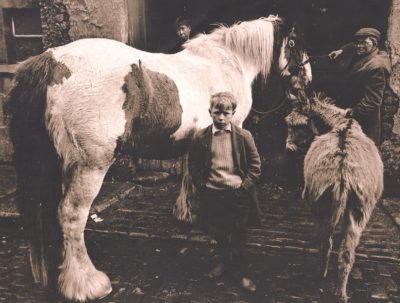My Dad is largely to blame … he was a very cultured man, big into music, literature and movies. From when I was fourteen or so, he took me regularly to Dublin’s art-house cinema to see all the great movies of the time, by the likes of Bergman, Fellini, Visconti, Antonioni, Pasolini. My favourite film of all time is still Fellini’s “8½”.
Virtually all these great movies, including 8½, are in black and white and I guess that’s where my abiding love of B&W comes from. It may also be where my love of all things Italian comes from …
(Incidentally, I got the DVD of 8½ about ten years ago, but I couldn’t bear to play it at first: what if I didn’t like it half as much the second time around? What if it was rubbish? I eventually put it on a week later: it was even better than I remembered. And as a man then in his 60’s, I understood it so much more than I did as an adolescent. First time, I hadn’t got how humourous it is: there’s a dream sequence where all the women in the hero’s life tell him how wonderful he is – it’s very funny. Highly recommended)
I decided I wanted to be a movie director. I went to University to study English Literature and Language so I could learn how to write. I wanted to be the Irish Fellini – or maybe the James Joyce who went on to make movies. Then I realised I had no visual training – how to put things into a frame – so I decided to take up photography as a hobby to correct this deficiency.
I used to borrow a camera and darkroom from a college friend, Ian Finlay, who was an excellent amateur snapper. We both later became professionals at the same time. More about him in a later blog post …
So when I was first got into photography in the late 1960’s, my first impulse was to do street photographs in black and white. Dublin in the late 60’s was still very much a city built in the eighteenth and nineteenth centuries. What is now Temple Bar was simply a warren of deserted warehouses and small factories. Lots of the buildings were falling to bits – which often makes them very photogenic. Same goes for lots of the people I bumped into … I was quite shocked at the levels of poverty and decrepitude I encountered in those parts of the city I had never ventured into before.
Street is still a favourite topic, as the variety is infinite. The first few rolls I shot weren’t anything special, and this picture was the first one that made me think ‘I could get quite good at this’.
 Everything just came together: I saw the location and the huge cart-horse up a little alleyway near the centre of Dublin, and strolled up to find this ancient forge, straight out of the nineteenth century. As I put the camera to my eye, the lad at the front struck a pose, the lad at the back popped up out of nowhere, and the donkey looked around to see what was happening. Click – one frame only, then it all faded away, back to the way it was.
Everything just came together: I saw the location and the huge cart-horse up a little alleyway near the centre of Dublin, and strolled up to find this ancient forge, straight out of the nineteenth century. As I put the camera to my eye, the lad at the front struck a pose, the lad at the back popped up out of nowhere, and the donkey looked around to see what was happening. Click – one frame only, then it all faded away, back to the way it was.
I was also trying out a new technique I had read about, with Kodak Tri-X rated 2 stops faster and developed in a really weird solution: Agfa Rodinal mixed 1 part developer to 75 parts water. The negative was so incredibly thin that I thought it would never print. You could hardly see anything. However, it had the most beautiful range of tones right through from black to white, and everything in between. I’m still very fond of this picture, 52 years on …
In the 1980’s, my dear friend and fellow-snapper, the late Kevin Dunne, bought the building directly opposite the forge and made his studio there. He was very fond of this shot too and asked me for a print which he framed and hung on his office wall. By then the whole area had been gentrified, with mews houses, artists’ workshops etc. They should have kept the cobbles …
